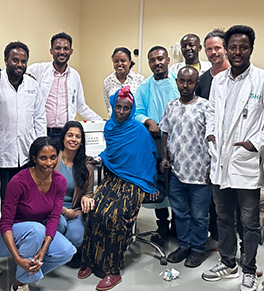
Uterine Cancer
Discover personalized care for uterine cancer with a team dedicated to your health, treatment and support — every step of the way
Our compassionate team of experts is dedicated to providing personalized, innovative care to help you navigate this journey.
Signs and symptoms of uterine cancer
Uterine cancer is the most common cancer of the female reproductive system, with approximately 65,000 women in the U.S. diagnosed each year. But with early detection and advanced treatments, many women can overcome it and return to living their full lives.
Symptoms
If you're experiencing any of the following symptoms, it’s important to contact your doctor right away. While they can be caused by other conditions, they should never be ignored.
Postmenopausal bleeding: Bleeding after menopause, whether light spotting or heavier bleeding, is not normal and should be checked by your doctor immediately.
Irregular periods: If your periods are becoming irregular, especially if you have polycystic ovary syndrome (PCOS), it could be a sign of uterine cancer.
Less common symptoms
Less common symptoms include pelvic pain, bloating or cramping, and the presence of a pelvic mass, especially one that is growing in size.
Risk factors
Obesity and hormonal therapy: If you’re obese or taking unopposed estrogen or tamoxifen, abnormal vaginal bleeding could be a symptom of uterine cancer.
Early detection is key, so contact your doctor if you notice any of these symptoms.

Get comprehensive uterine cancer care at UCI Health
Contact us today to schedule a consultation with our expert team. Explore personalized treatment options for uterine cancer, backed by advanced care and innovative research.
Call 714-456-8000 to learn how our specialists can optimize your treatment and recovery.

Find a cancer clinical trial
Talk to your doctor to see if a cancer clinical trial is right for you.
Featured Blog Posts

Medical mission brings advanced radiation therapy to fight cervical cancer in Ethiopia
UCI Health radiation oncologist Dr. Priya Mitra trained local medical staff in the lifesaving treatment.

HPV-related oral cancers soar among men

A 'dream come true' realized in Irvine
Dr. Michael J. Stamos once envisioned opening a small cancer center on the UC Irvine campus. What has emerged, he says, is so much more.
Uterine cancer diagnosis at UCI Health
We use a variety of methods to diagnose uterine cancer and get you the most accurate information. Here’s what you can expect during the diagnostic process.
Biopsy: We diagnose most uterine cancer cases with a biopsy, where we take a small tissue sample from the lining of your uterus. We usually perform an in-office procedure, passing a thin tube through the cervix. It’s quick, doesn’t require anesthesia and may cause brief cramping.
D&C procedure: If we can’t perform a biopsy in the office, you may need a dilation and curettage (D&C) procedure. This outpatient procedure may include a small camera (hysteroscope) to look inside your uterus and collect tissue for testing.
Pathology results: We send your tissue sample to a pathologist for examination. If we find cancer, the pathologist will determine the grade and type of cells, which helps your doctor understand how aggressive the cancer may be.
If you have questions or concerns about the diagnostic process, we’re here to guide you every step of the way.
Staging
When we diagnose uterine cancer, one of the most important factors in deciding your treatment and predicting your outlook is the stage of the cancer. Staging helps doctors understand how far the cancer has spread and what the best treatment options may be.
Stages of uterine cancer
- Stage I: Cancer is confined to the body (corpus) of the uterus.
- Stage II: Cancer has spread to the uterine cervix.
- Stage III: Cancer has spread to the fallopian tubes, ovaries, vagina, or lymph nodes.
- Stage IV: Cancer has spread to the bladder or colon lining, or to the upper abdomen, lungs, or groin lymph nodes.
Knowing the stage of your cancer is crucial. It helps guide your treatment plan and gives your doctor a clearer idea of what to expect moving forward.
Uterine cancer treatment at UCI Health
At UCI Health, we offer personalized, expert care to treat uterine cancer. Our team of specialists works closely together to provide the most effective treatment options, focused on your unique needs and overall well-being.
Managing recurrent disease
If uterine cancer returns, treatment becomes more complex. At UCI Health, we carefully assess factors such as the location of recurrence, previous treatments and your overall health to develop a tailored plan. Many patients with recurrent disease are eligible for clinical trials.These new therapies could provide additional treatment options.
Your patient pathway
At UCI Health, your care pathway may include:
- Initial consultation: Discuss your diagnosis and treatment options with our team.
- Surgical consultation: If you need surgery, we’ll explain the best approach for you.
- Chemotherapy or radiation: Based on your stage, treatment may include chemotherapy, radiation or both.
- Ongoing care: Continuous support and access to clinical trials for the best outcomes.
With advanced treatments and personalized care, we’re with you every step of the way, helping you navigate uterine cancer treatment with confidence.
Why choose UCI Health for uterine cancer care
NCI-designated cancer center
UCI Health is proud to be home to the Chao Family Comprehensive Cancer Center. We’re the only cancer center in Orange County designated by the National Cancer Institute (NCI). This means you have access to the most advanced treatments, experienced specialists and the latest in cancer research—all tailored to meet your unique needs.
University-affiliated care
As the only academic health system in Orange County, we bring together expert care with the latest innovations. As a teaching hospital, we offer personalized treatment options and the opportunity to be part of leading-edge clinical trials, ensuring you receive the most effective and up-to-date care available.
Innovative treatments
We were among the first in the region to offer hyperthermic intraperitoneal chemotherapy or HIPEC, a unique treatment designed to kill ovarian cancer cells left behind after surgery.
Treating the whole you
You are much more than your diagnosis. When we care for you, we take into account every aspect of your life, including menopause, bone and sexual health, memory and fatigue.
We offer advanced, compassionate care, combining leading-edge treatments with personalized support.
Our physicians — gynecologic oncologists, surgeons, oncologists, radiologists and pathologists — work together to provide you with comprehensive and individualized care.




